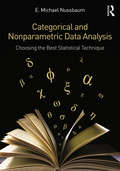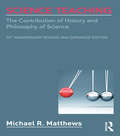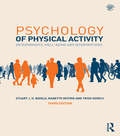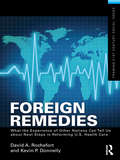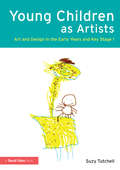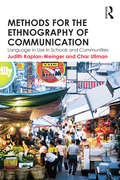- Table View
- List View
How to be a Brilliant FE Teacher: A practical guide to being effective and innovative
by Vicky DuckworthHow to be a Brilliant FE Teacher is a straightforward, friendly guide to being an effective and innovative teacher in post-compulsory education. Focussing on practical advice drawn from the author’s extensive and successful personal experience of both teaching and training teachers, it offers sound guidance, underpinned by the latest research, theory and policy in the field. Structured around the questions that all new teachers and lecturers ask in their first teaching post, it is an introduction to both essential teaching skills and what to expect from working in this exciting, fast-paced sector. Key chapters cover: The learners – who they are, diversity and motivation; What will actually happen – organising teaching, technology and resources; How to keep your students’ interest – understanding and responding to learning styles; How will I know if they’ve learned it? – assessment and feedback; Making sure it’s working – student evaluation, reflecting on and improving practice. Packed throughout with information about where to find the best materials and resources to support your teaching, this book also offers sensible advice on balancing home and life, working effectively with your colleagues and progressing in your career. How to be a Brilliant FE Teacher will be a source of support and inspiration for all those embarking on their initial training and first post in the sector, as well as qualified professionals looking for reassuring, fresh ideas.
Categorical and Nonparametric Data Analysis: Choosing the Best Statistical Technique
by E. Michael NussbaumFeaturing in-depth coverage of categorical and nonparametric statistics, this book provides a conceptual framework for choosing the most appropriate type of test in various research scenarios. Class tested at the University of Nevada, the book's clear explanations of the underlying assumptions, computer simulations, and Exploring the Concept boxes help reduce reader anxiety. Problems inspired by actual studies provide meaningful illustrations of the techniques. The underlying assumptions of each test and the factors that impact validity and statistical power are reviewed so readers can explain their assumptions and how tests work in future publications. Numerous examples from psychology, education, and other social sciences demonstrate varied applications of the material. Basic statistics and probability are reviewed for those who need a refresher. Mathematical derivations are placed in optional appendices for those interested in this detailed coverage. Highlights include the following: Unique coverage of categorical and nonparametric statistics better prepares readers to select the best technique for their particular research project; however, some chapters can be omitted entirely if preferred. Step-by-step examples of each test help readers see how the material is applied in a variety of disciplines. Although the book can be used with any program, examples of how to use the tests in SPSS and Excel foster conceptual understanding. Exploring the Concept boxes integrated throughout prompt students to review key material and draw links between the concepts to deepen understanding. Problems in each chapter help readers test their understanding of the material. Emphasis on selecting tests that maximize power helps readers avoid "marginally" significant results. Website (www.routledge.com/9781138787827) features datasets for the book's examples and problems, and for the instructor, PowerPoint slides, sample syllabi, answers to the even-numbered problems, and Excel data sets for lecture purposes. Intended for individual or combined graduate or advanced undergraduate courses in categorical and nonparametric data analysis, cross-classified data analysis, advanced statistics and/or quantitative techniques taught in psychology, education, human development, sociology, political science, and other social and life sciences, the book also appeals to researchers in these disciplines. The nonparametric chapters can be deleted if preferred. Prerequisites include knowledge of t tests and ANOVA.
Categorical and Nonparametric Data Analysis: Choosing the Best Statistical Technique
by E. Michael NussbaumFeaturing in-depth coverage of categorical and nonparametric statistics, this book provides a conceptual framework for choosing the most appropriate type of test in various research scenarios. Class tested at the University of Nevada, the book's clear explanations of the underlying assumptions, computer simulations, and Exploring the Concept boxes help reduce reader anxiety. Problems inspired by actual studies provide meaningful illustrations of the techniques. The underlying assumptions of each test and the factors that impact validity and statistical power are reviewed so readers can explain their assumptions and how tests work in future publications. Numerous examples from psychology, education, and other social sciences demonstrate varied applications of the material. Basic statistics and probability are reviewed for those who need a refresher. Mathematical derivations are placed in optional appendices for those interested in this detailed coverage. Highlights include the following: Unique coverage of categorical and nonparametric statistics better prepares readers to select the best technique for their particular research project; however, some chapters can be omitted entirely if preferred. Step-by-step examples of each test help readers see how the material is applied in a variety of disciplines. Although the book can be used with any program, examples of how to use the tests in SPSS and Excel foster conceptual understanding. Exploring the Concept boxes integrated throughout prompt students to review key material and draw links between the concepts to deepen understanding. Problems in each chapter help readers test their understanding of the material. Emphasis on selecting tests that maximize power helps readers avoid "marginally" significant results. Website (www.routledge.com/9781138787827) features datasets for the book's examples and problems, and for the instructor, PowerPoint slides, sample syllabi, answers to the even-numbered problems, and Excel data sets for lecture purposes. Intended for individual or combined graduate or advanced undergraduate courses in categorical and nonparametric data analysis, cross-classified data analysis, advanced statistics and/or quantitative techniques taught in psychology, education, human development, sociology, political science, and other social and life sciences, the book also appeals to researchers in these disciplines. The nonparametric chapters can be deleted if preferred. Prerequisites include knowledge of t tests and ANOVA.
Science Teaching: The Contribution of History and Philosophy of Science, 20th Anniversary Revised and Expanded Edition
by Michael R. MatthewsScience Teaching explains how history and philosophy of science contributes to the resolution of persistent theoretical, curricular, and pedagogical issues in science education. It shows why it is essential for science teachers to know and appreciate the history and philosophy of the subject they teach and how this knowledge can enrich science instruction and enthuse students in the subject. Through its historical perspective, the book reveals to students, teachers, and researchers the foundations of scientific knowledge and its connection to philosophy, metaphysics, mathematics, and broader social influences including the European Enlightenment, and develops detailed arguments about constructivism, worldviews and science, multicultural science education, inquiry teaching, values, and teacher education. Fully updated and expanded, the 20th Anniversary Edition of this classic text, featuring four new chapters—The Enlightenment Tradition; Joseph Priestley and Photosynthesis; Science, Worldviews and Education; and Nature of Science Research—and 1,300 references, provides a solid foundation for teaching and learning in the field.
Science Teaching: The Contribution of History and Philosophy of Science, 20th Anniversary Revised and Expanded Edition
by Michael R. MatthewsScience Teaching explains how history and philosophy of science contributes to the resolution of persistent theoretical, curricular, and pedagogical issues in science education. It shows why it is essential for science teachers to know and appreciate the history and philosophy of the subject they teach and how this knowledge can enrich science instruction and enthuse students in the subject. Through its historical perspective, the book reveals to students, teachers, and researchers the foundations of scientific knowledge and its connection to philosophy, metaphysics, mathematics, and broader social influences including the European Enlightenment, and develops detailed arguments about constructivism, worldviews and science, multicultural science education, inquiry teaching, values, and teacher education. Fully updated and expanded, the 20th Anniversary Edition of this classic text, featuring four new chapters—The Enlightenment Tradition; Joseph Priestley and Photosynthesis; Science, Worldviews and Education; and Nature of Science Research—and 1,300 references, provides a solid foundation for teaching and learning in the field.
The Routledge Intermediate Persian Course: Farsi Shirin Ast, Book Two
by Dominic Parviz Brookshaw Pouneh Shabani-JadidiThe Routledge Intermediate Persian Course: Farsi Shirin Ast, Book Two is the first intermediate level Persian textbook written specifically for English-speaking university students that makes use of up-to-date pedagogical techniques, and stresses the importance of communicative competence. The diversity of the texts in this textbook helps to familiarize students with a range of literary genres, and provides them with the necessary building blocks to continue reading on their own. One of the distinctive features of this book is the approach to language learning it is based on; all the material contained in it is geared towards a content-based and task-based approach to learning the language. This approach enhances a student-centred class environment. As with The Routledge Introductory Persian Course, all the texts in this volume are available online in the form of audio files. These texts are recorded by native speakers and available for instructors and students to download freely at http://www.routledge.com/books/details/9780415691376/. The Routledge Intermediate Persian Course: Farsi Shirin Ast, Book Two follows on where the first textbook ends and is ideal for all intermediate learners of Persian in their second year of study. .
The Routledge Intermediate Persian Course: Farsi Shirin Ast, Book Two
by Dominic Parviz Brookshaw Pouneh Shabani-JadidiThe Routledge Intermediate Persian Course: Farsi Shirin Ast, Book Two is the first intermediate level Persian textbook written specifically for English-speaking university students that makes use of up-to-date pedagogical techniques, and stresses the importance of communicative competence. The diversity of the texts in this textbook helps to familiarize students with a range of literary genres, and provides them with the necessary building blocks to continue reading on their own. One of the distinctive features of this book is the approach to language learning it is based on; all the material contained in it is geared towards a content-based and task-based approach to learning the language. This approach enhances a student-centred class environment. As with The Routledge Introductory Persian Course, all the texts in this volume are available online in the form of audio files. These texts are recorded by native speakers and available for instructors and students to download freely at http://www.routledge.com/books/details/9780415691376/. The Routledge Intermediate Persian Course: Farsi Shirin Ast, Book Two follows on where the first textbook ends and is ideal for all intermediate learners of Persian in their second year of study. .
Research Methods in Second Language Psycholinguistics
by Jill Jegerski Bill VanPattenAddressing a rapidly growing interest in second language research, this hands-on text provides students and researchers with the means to understand and use current methods in psycholinguistics. With a focus on the actual methods, designs, and techniques used in psycholinguistics research as they are applied to second language learners, this book offers the practical guidance readers need to determine which method is the best for what they wish to investigate as well as the tools that will enhance their research. Each methods chapter is written by a leading expert who describes, discusses, and comments on how a method is used and what its strengths and limitations are for second language research. These chapters follow a specific format to ensure cohesion and a predictable structure across all chapters. The chapters also inform the novice researcher on such key issues as ease of use, costs, potential pitfalls, and other related matters, each of which impact decisions that researchers make about the paths they take. With the most reliable information available from experienced reseachers, Research Methods in Second Language Psycholinguistics is an essential resource for anyone interested in conducting second language reserach using psycholinguistic methods.
Research Methods in Second Language Psycholinguistics
by Jill Jegerski Bill VanPattenAddressing a rapidly growing interest in second language research, this hands-on text provides students and researchers with the means to understand and use current methods in psycholinguistics. With a focus on the actual methods, designs, and techniques used in psycholinguistics research as they are applied to second language learners, this book offers the practical guidance readers need to determine which method is the best for what they wish to investigate as well as the tools that will enhance their research. Each methods chapter is written by a leading expert who describes, discusses, and comments on how a method is used and what its strengths and limitations are for second language research. These chapters follow a specific format to ensure cohesion and a predictable structure across all chapters. The chapters also inform the novice researcher on such key issues as ease of use, costs, potential pitfalls, and other related matters, each of which impact decisions that researchers make about the paths they take. With the most reliable information available from experienced reseachers, Research Methods in Second Language Psycholinguistics is an essential resource for anyone interested in conducting second language reserach using psycholinguistic methods.
Understanding American Political Parties: Democratic Ideals, Political Uncertainty, and Strategic Positioning
by Jeffrey M. StonecashHow do parties respond to the electorate and craft winning strategies? In the abstract parties are the vehicles to make democracy work, but it is often difficult to see the process working as well as we think it might. Indeed, voters often struggle to see parties as the valuable vehicles of representation that so many academics describe. There is a clear discrepancy between the ideal expressed in many textbooks and the reality that we see playing out in politics. Noted scholar Jeffrey Stonecash gives us a big picture analysis that helps us understand what is happening in contemporary party politics. He explains that parties behave the way they do because of existing political conditions and how parties adapt to those conditions as they prepare for the next election. Parties are unsure if realignment has stabilized and just what issues brought them their current base. Does a majority support their positions and how are they to react to ongoing social change? Is the electorate paying attention, and can parties get a clear message to those voters? This book focuses on the challenges parties face in preparing for future elections while seeking to cope with current conditions. This coping leads to indecisiveness of positioning, simplification of issues, repetition of messages, and efforts to disparage the reputation of the opposing party. Stonecash sheds much needed light on why parties engage in the practices that frustrate so many Americans.
Understanding American Political Parties: Democratic Ideals, Political Uncertainty, and Strategic Positioning
by Jeffrey M. StonecashHow do parties respond to the electorate and craft winning strategies? In the abstract parties are the vehicles to make democracy work, but it is often difficult to see the process working as well as we think it might. Indeed, voters often struggle to see parties as the valuable vehicles of representation that so many academics describe. There is a clear discrepancy between the ideal expressed in many textbooks and the reality that we see playing out in politics. Noted scholar Jeffrey Stonecash gives us a big picture analysis that helps us understand what is happening in contemporary party politics. He explains that parties behave the way they do because of existing political conditions and how parties adapt to those conditions as they prepare for the next election. Parties are unsure if realignment has stabilized and just what issues brought them their current base. Does a majority support their positions and how are they to react to ongoing social change? Is the electorate paying attention, and can parties get a clear message to those voters? This book focuses on the challenges parties face in preparing for future elections while seeking to cope with current conditions. This coping leads to indecisiveness of positioning, simplification of issues, repetition of messages, and efforts to disparage the reputation of the opposing party. Stonecash sheds much needed light on why parties engage in the practices that frustrate so many Americans.
Psychology of Physical Activity: Determinants, Well-Being and Interventions
by Stuart J. Biddle Nanette Mutrie Trish GorelyThe positive benefits of physical activity for physical and mental health are now widely acknowledged, yet levels of physical inactivity continue to increase throughout the developed world. Understanding the psychology of physical activity has therefore become an important concern for scientists, health professionals and policy-makers alike. Psychology of Physical Activity is a comprehensive and in-depth introduction to the fundamentals of exercise psychology, from theories of motivation and adherence to the design of successful interventions for increasing participation. Now in a fully revised, updated and expanded third edition, Psychology of Physical Activity is still the only textbook to offer a full survey of the evidence-base for theory and practice in exercise psychology, and the only textbook that explains how to interpret the quality of the research evidence. With international cases, examples and data included throughout, the book also provides a thoroughly detailed examination of the relationship between physical activity and mental health. A full companion website offers useful features to help students and lecturers get the most out of the book during their course, including multiple-choice revision questions, PowerPoint slides and a test bank of additional learning activities. Psychology of Physical Activity is the most authoritative, engaging and up-to-date introduction to exercise psychology currently available. It is essential reading for all students working in exercise and health sciences.
Psychology of Physical Activity: Determinants, Well-Being and Interventions
by Stuart J. Biddle Nanette Mutrie Trish GorelyThe positive benefits of physical activity for physical and mental health are now widely acknowledged, yet levels of physical inactivity continue to increase throughout the developed world. Understanding the psychology of physical activity has therefore become an important concern for scientists, health professionals and policy-makers alike. Psychology of Physical Activity is a comprehensive and in-depth introduction to the fundamentals of exercise psychology, from theories of motivation and adherence to the design of successful interventions for increasing participation. Now in a fully revised, updated and expanded third edition, Psychology of Physical Activity is still the only textbook to offer a full survey of the evidence-base for theory and practice in exercise psychology, and the only textbook that explains how to interpret the quality of the research evidence. With international cases, examples and data included throughout, the book also provides a thoroughly detailed examination of the relationship between physical activity and mental health. A full companion website offers useful features to help students and lecturers get the most out of the book during their course, including multiple-choice revision questions, PowerPoint slides and a test bank of additional learning activities. Psychology of Physical Activity is the most authoritative, engaging and up-to-date introduction to exercise psychology currently available. It is essential reading for all students working in exercise and health sciences.
Torture: A Sociology of Violence and Human Rights
by Lisa HajjarTorture is indisputably abhorrent. Why, you might ask, would you even want to think or read about torture? That is a very good question, and one this book addresses in a compelling and enlightening way. Torture is a very important issue, not least because millions of people around the world have been subjected to this odious practice—and many are enduring torture right now as you read these words.
Torture: A Sociology of Violence and Human Rights
by Lisa HajjarTorture is indisputably abhorrent. Why, you might ask, would you even want to think or read about torture? That is a very good question, and one this book addresses in a compelling and enlightening way. Torture is a very important issue, not least because millions of people around the world have been subjected to this odious practice—and many are enduring torture right now as you read these words.
Foreign Remedies: What the Experience of Other Nations Can Tell Us about Next Steps in Reforming U.S. Health Care
by David A. Rochefort Kevin P DonnellyThe Patient Protection and Affordable Care Act marked a watershed in U.S. health policy, but controversy over its passage rages on, and much uncertainty surrounds the law’s transformation from blueprint into operational program. How can the experience of other nations help us to reconcile the competing goals of universal coverage, cost control, and high quality care? Following an analysis of the 2010 statute, this book surveys developments in different parts of the globe to identify important lessons in health politics, policy design, and program implementation. A concluding chapter examines the issue of resistance to foreign remedies within the process of U.S. health reform.
Foreign Remedies: What the Experience of Other Nations Can Tell Us about Next Steps in Reforming U.S. Health Care
by David A. Rochefort Kevin P DonnellyThe Patient Protection and Affordable Care Act marked a watershed in U.S. health policy, but controversy over its passage rages on, and much uncertainty surrounds the law’s transformation from blueprint into operational program. How can the experience of other nations help us to reconcile the competing goals of universal coverage, cost control, and high quality care? Following an analysis of the 2010 statute, this book surveys developments in different parts of the globe to identify important lessons in health politics, policy design, and program implementation. A concluding chapter examines the issue of resistance to foreign remedies within the process of U.S. health reform.
Lifelong Learning in the UK: An introductory guide for Education Studies
by Anne O'GradyWritten specifically for Education Studies students, this accessible text offers a clear introduction to lifelong learning and the impact it has on all areas of society. Assuming no prior knowledge of the subject, it explores what lifelong learning is, where learning can and does take place and who is accessing it. Offering a clear overview of the different strands to lifelong learning, the book examines the concept of lifelong learning drawing on key policy initiatives and strategies. Each section outlines the types of individuals who are most likely to access lifelong learning within and across these strands including, for example, migrants, refugees and asylum seekers, unemployed adults, carers and guardians, older age-groups and returning learners. Chapters cover: adult and community learning; higher education; further education; work-based learning; prison and probation learning. Including supporting tasks and reflection activities, this textbook will give students a broad understanding of lifelong learning and its role in supporting adults throughout their life both socially and economically. Lifelong Learning in the UK is an essential introductory text for students on undergraduate courses in Education Studies.
Lifelong Learning in the UK: An introductory guide for Education Studies
by Anne O'GradyWritten specifically for Education Studies students, this accessible text offers a clear introduction to lifelong learning and the impact it has on all areas of society. Assuming no prior knowledge of the subject, it explores what lifelong learning is, where learning can and does take place and who is accessing it. Offering a clear overview of the different strands to lifelong learning, the book examines the concept of lifelong learning drawing on key policy initiatives and strategies. Each section outlines the types of individuals who are most likely to access lifelong learning within and across these strands including, for example, migrants, refugees and asylum seekers, unemployed adults, carers and guardians, older age-groups and returning learners. Chapters cover: adult and community learning; higher education; further education; work-based learning; prison and probation learning. Including supporting tasks and reflection activities, this textbook will give students a broad understanding of lifelong learning and its role in supporting adults throughout their life both socially and economically. Lifelong Learning in the UK is an essential introductory text for students on undergraduate courses in Education Studies.
Young Children as Artists: Art and Design in the Early Years and Key Stage 1
by Suzy TutchellFrom the moment a child is born, they interact with the sensory world, looking at colours, feeling textures; constructing mental and physical images of what they see and experience. Within all early years settings and into primary school, the aim for the practitioner, is to provide as many opportunities as possible to stimulate, excite and ignite the visual and tactile imagination of the young children they teach. Young Children as Artists considers how art can be managed, understood and relished as an essential ingredient towards the creative potential of each unique young child. The book focuses, on how to enjoy, celebrate and extend what a young child can do in art and show how engaged adults and the wider school community can become confident participants in the process of early years art making. Full of practical advice, on to how to design, develop, resource and extend art and design environments within the early years setting, the book covers: Developing skills for positive and participative adult interaction and engagement Understanding and analysing child involvement in art Planning for opportunities and responding to observation and schema in art and design Practical suggestions for activities and resources (inside and out) Ideas to explore sensory development and awareness Ways to manage and savour the art transition into KS1 Ways to encourage parental participation and understanding of the art process with their children Opportunities to engage with practising artists This book will help to invigorate the art experiences offered in your early years setting by considering what is accessible, individual, inspiring and meaningful for young children and how you can best support their formative paths of enquiry.
Young Children as Artists: Art and Design in the Early Years and Key Stage 1
by Suzy TutchellFrom the moment a child is born, they interact with the sensory world, looking at colours, feeling textures; constructing mental and physical images of what they see and experience. Within all early years settings and into primary school, the aim for the practitioner, is to provide as many opportunities as possible to stimulate, excite and ignite the visual and tactile imagination of the young children they teach. Young Children as Artists considers how art can be managed, understood and relished as an essential ingredient towards the creative potential of each unique young child. The book focuses, on how to enjoy, celebrate and extend what a young child can do in art and show how engaged adults and the wider school community can become confident participants in the process of early years art making. Full of practical advice, on to how to design, develop, resource and extend art and design environments within the early years setting, the book covers: Developing skills for positive and participative adult interaction and engagement Understanding and analysing child involvement in art Planning for opportunities and responding to observation and schema in art and design Practical suggestions for activities and resources (inside and out) Ideas to explore sensory development and awareness Ways to manage and savour the art transition into KS1 Ways to encourage parental participation and understanding of the art process with their children Opportunities to engage with practising artists This book will help to invigorate the art experiences offered in your early years setting by considering what is accessible, individual, inspiring and meaningful for young children and how you can best support their formative paths of enquiry.
Methods for the Ethnography of Communication: Language in Use in Schools and Communities (1st Edition)
by Judith Kaplan-WeingerMethods for the Ethnography of Communication is a guide to conducting ethnographic research in classroom and community settings that introduces students to the field of ethnography of communication, and takes them through the recursive and nonlinear cycle of ethnographic research. Drawing on the mnemonic that Hymes used to develop the Ethnography of SPEAKING, the authors introduce the innovative CULTURES framework to provide a helpful structure for moving through the complex process of collecting and analyzing ethnographic data and addresses the larger how-to questions that students struggle with when undertaking ethnographic research. Exercises and activities help students make the connection between communicative events, acts, and situations and ways of studying them ethnographically. Integrating a primary focus on language in use within an ethnographic framework makes this book an invaluable core text for courses on ethnography of communication and related areas in a variety of disciplines. Methods for the Ethnography of Communication is a guide to conducting ethnographic research in classroom and community settings that introduces students to the field of ethnography of communication, and takes them through the recursive and nonlinear cycle of ethnographic research. Drawing on the mnemonic that Hymes used to develop the Ethnography of SPEAKING, the authors introduce the innovative CULTURES framework to provide a helpful structure for moving through the complex process of collecting and analyzing ethnographic data and addresses the larger how-to questions that students struggle with when undertaking ethnographic research. Exercises and activities help students make the connection between communicative events, acts, and situations and ways of studying them ethnographically. Integrating a primary focus on language in use within an ethnographic framework makes this book an invaluable core text for courses on ethnography of communication and related areas in a variety of disciplines.
Methods for the Ethnography of Communication: Language in Use in Schools and Communities (1st Edition) (PDF)
by Judith Kaplan-WeingerMethods for the Ethnography of Communication is a guide to conducting ethnographic research in classroom and community settings that introduces students to the field of ethnography of communication, and takes them through the recursive and nonlinear cycle of ethnographic research. Drawing on the mnemonic that Hymes used to develop the Ethnography of SPEAKING, the authors introduce the innovative CULTURES framework to provide a helpful structure for moving through the complex process of collecting and analyzing ethnographic data and addresses the larger how-to questions that students struggle with when undertaking ethnographic research. Exercises and activities help students make the connection between communicative events, acts, and situations and ways of studying them ethnographically. Integrating a primary focus on language in use within an ethnographic framework makes this book an invaluable core text for courses on ethnography of communication and related areas in a variety of disciplines. Methods for the Ethnography of Communication is a guide to conducting ethnographic research in classroom and community settings that introduces students to the field of ethnography of communication, and takes them through the recursive and nonlinear cycle of ethnographic research. Drawing on the mnemonic that Hymes used to develop the Ethnography of SPEAKING, the authors introduce the innovative CULTURES framework to provide a helpful structure for moving through the complex process of collecting and analyzing ethnographic data and addresses the larger how-to questions that students struggle with when undertaking ethnographic research. Exercises and activities help students make the connection between communicative events, acts, and situations and ways of studying them ethnographically. Integrating a primary focus on language in use within an ethnographic framework makes this book an invaluable core text for courses on ethnography of communication and related areas in a variety of disciplines.
Negotiating the Complexities of Qualitative Research in Higher Education: Fundamental Elements and Issues
by Susan R. Jones Vasti Torres Jan ArminioNegotiating the Complexities of Qualitative Research in Higher Education illuminates the complex nature of qualitative research, while attending to issues of application. This text addresses the fundamentals of research through discussion of strategies, ethical issues, and challenges in higher education. In addition to walking through the methodological steps, this text considers the conceptual reasons behind qualitative research and explores how to conduct qualitative research that is rigorous, thoughtful, and theoretically coherent. Seasoned researchers Jones, Torres, and Arminio combine high-level theory with practical applications and examples, showing how research in higher education can produce improved learning outcomes for students, especially those who have been historically marginalized. This book will help students in higher education and Student Affairs graduate programs to cultivate an appreciation for the complexity and ambiguity of the research and the ways to think thorough questions and tensions that emerge in the process. New in This Edition: Updated citations and content throughout to reflect the newest thinking and scholarship Expansion of current exemplars of qualitative research New exercises, activities, and examples throughout to bolster accessibility of theory A new chapter on Theoretical Perspectives with attention to new perspectives increasingly used in higher education and Student Affairs A new chapter on Challenges in Data Collection
Negotiating the Complexities of Qualitative Research in Higher Education: Fundamental Elements and Issues
by Susan R. Jones Vasti Torres Jan ArminioNegotiating the Complexities of Qualitative Research in Higher Education illuminates the complex nature of qualitative research, while attending to issues of application. This text addresses the fundamentals of research through discussion of strategies, ethical issues, and challenges in higher education. In addition to walking through the methodological steps, this text considers the conceptual reasons behind qualitative research and explores how to conduct qualitative research that is rigorous, thoughtful, and theoretically coherent. Seasoned researchers Jones, Torres, and Arminio combine high-level theory with practical applications and examples, showing how research in higher education can produce improved learning outcomes for students, especially those who have been historically marginalized. This book will help students in higher education and Student Affairs graduate programs to cultivate an appreciation for the complexity and ambiguity of the research and the ways to think thorough questions and tensions that emerge in the process. New in This Edition: Updated citations and content throughout to reflect the newest thinking and scholarship Expansion of current exemplars of qualitative research New exercises, activities, and examples throughout to bolster accessibility of theory A new chapter on Theoretical Perspectives with attention to new perspectives increasingly used in higher education and Student Affairs A new chapter on Challenges in Data Collection

